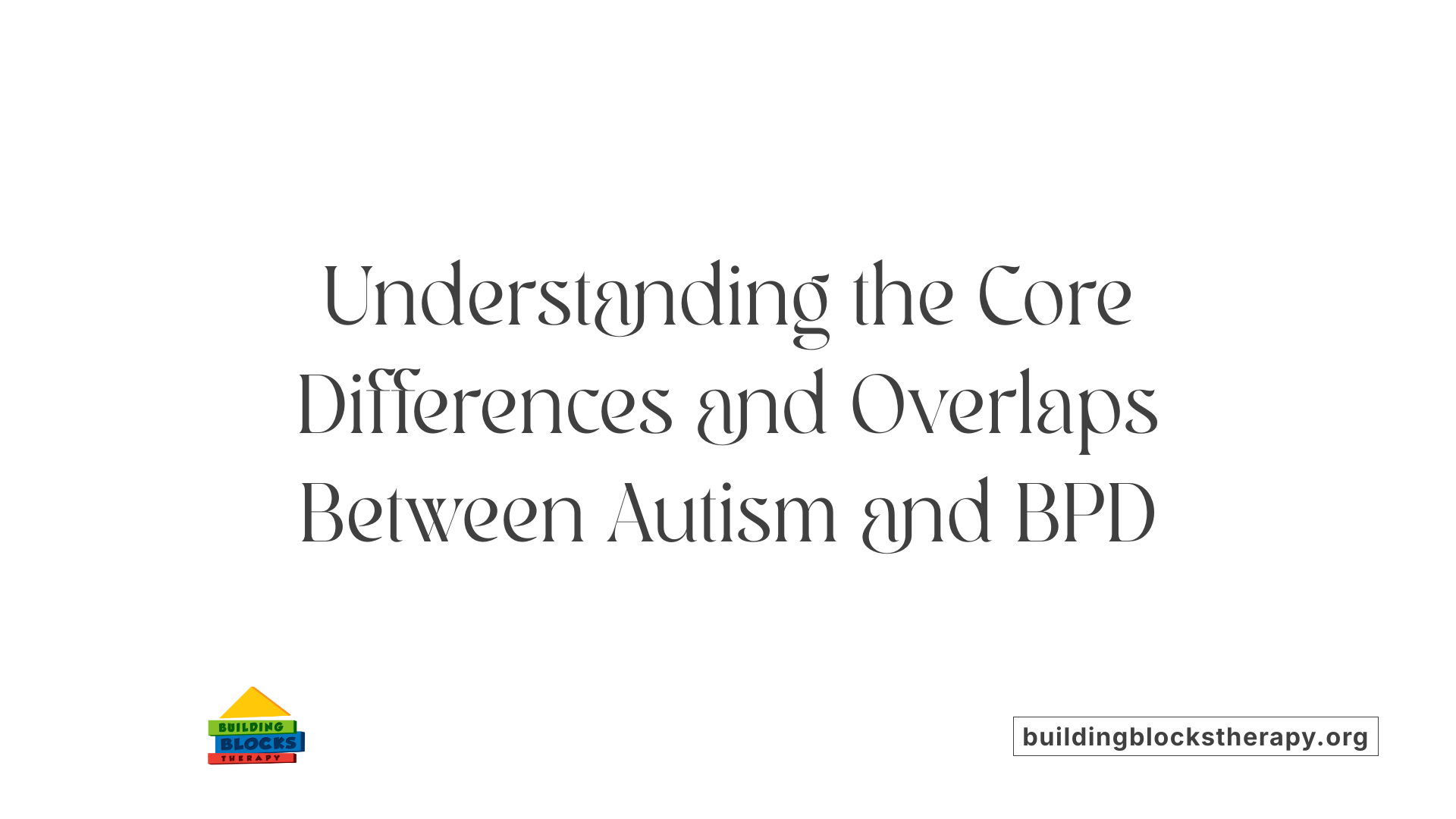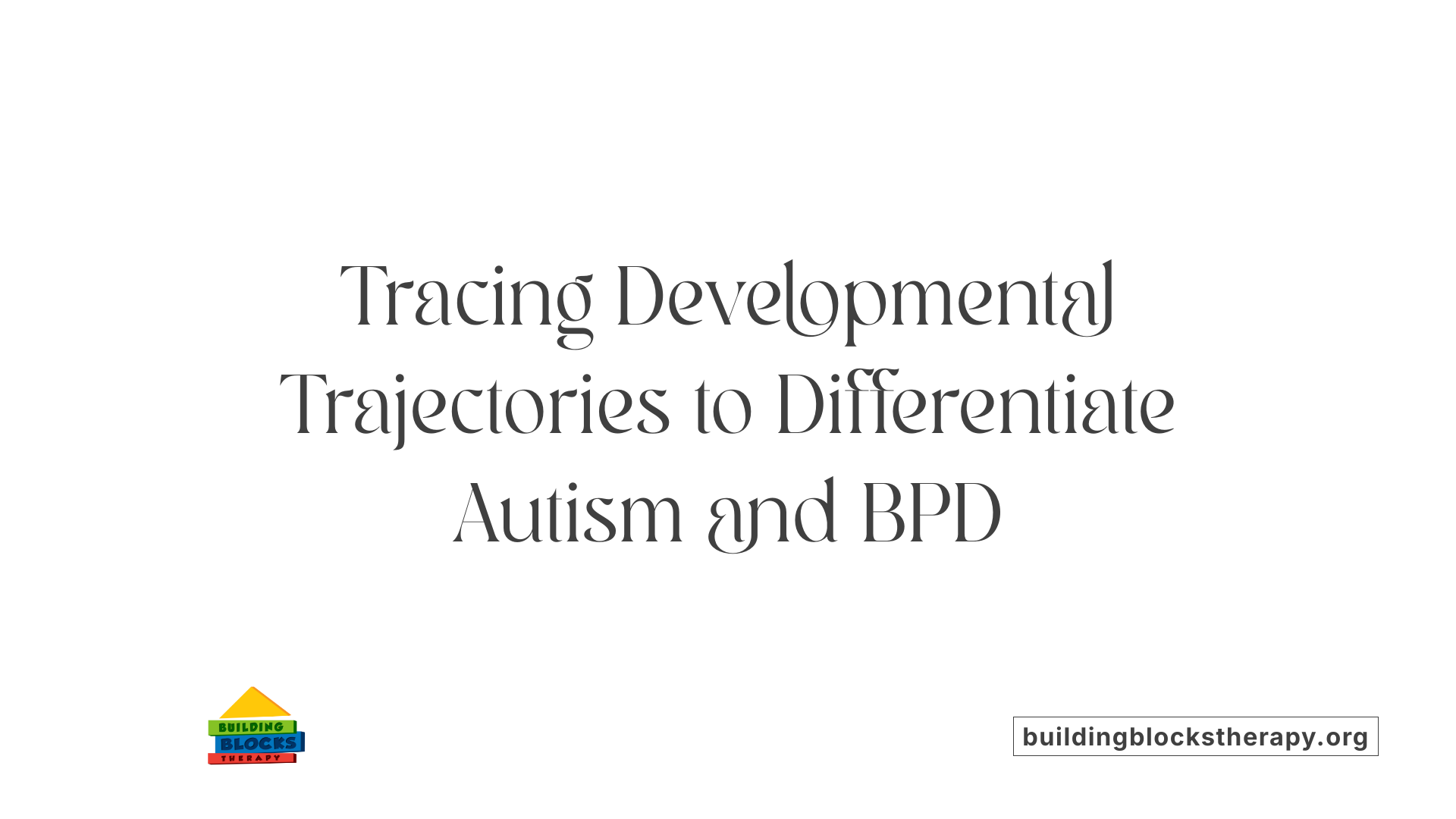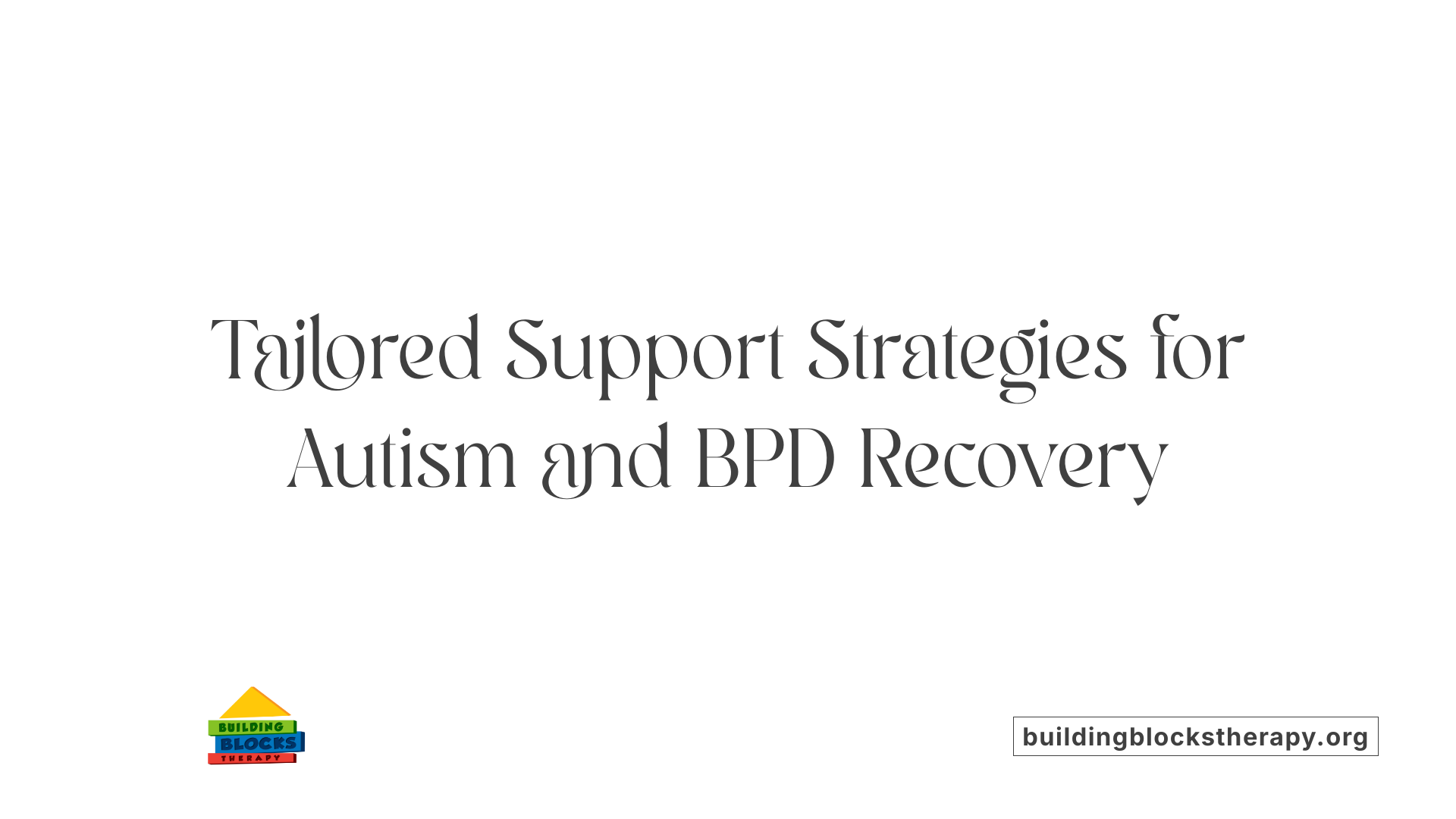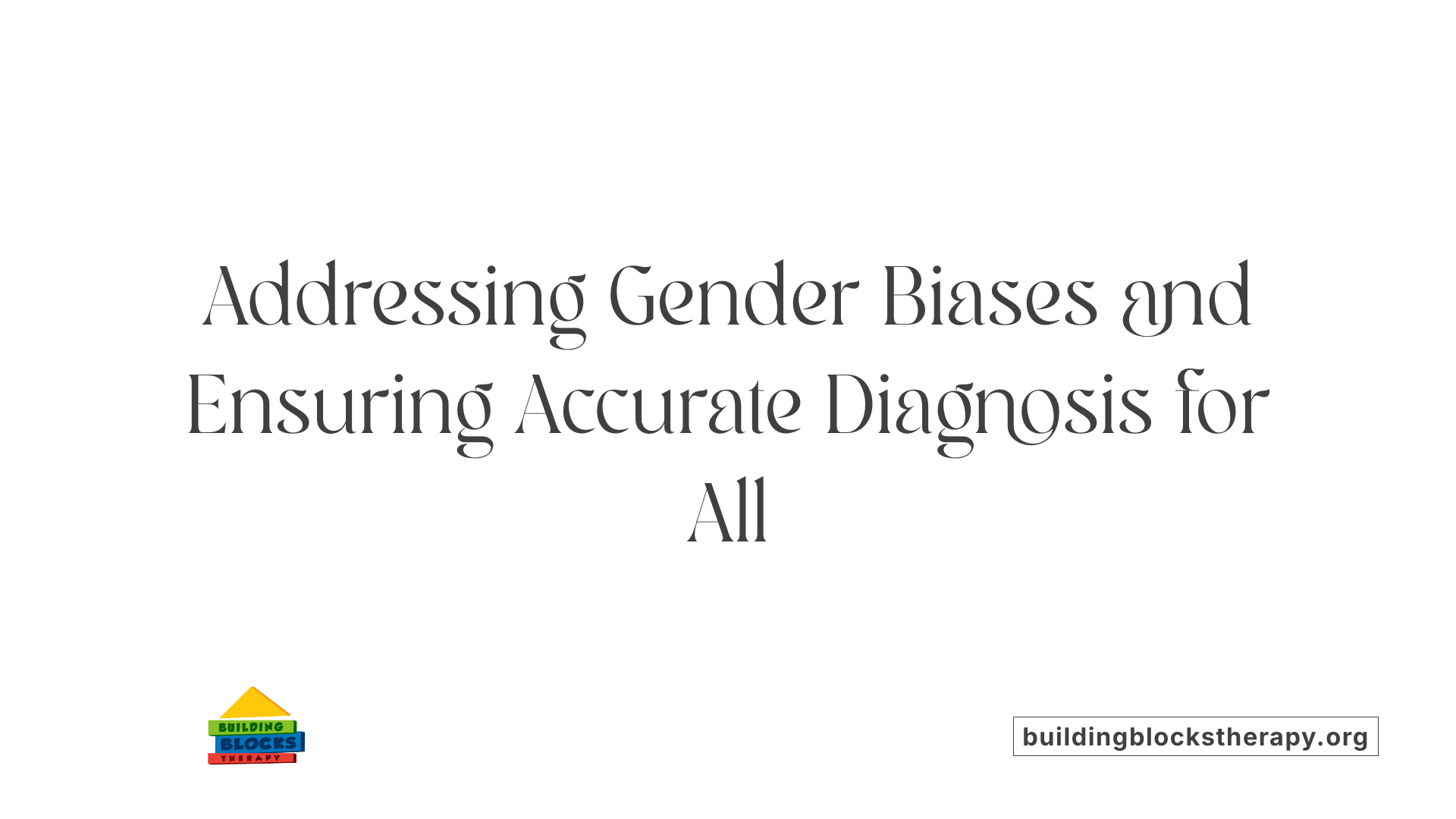Autism vs BPD
Unraveling the Complexities of Autism and BPD

Understanding Autism and Borderline Personality Disorder
Autism Spectrum Disorder (ASD) and Borderline Personality Disorder (BPD) are distinct mental health conditions that often exhibit overlapping symptoms, creating challenges in diagnosis and treatment. This article explores their core differences, similarities, research insights, and support strategies to enhance understanding and provide clarity for individuals, families, and healthcare professionals.
Core Features and Diagnostic Criteria

What are the core differences and similarities between Autism Spectrum Disorder and Borderline Personality Disorder?
Autism Spectrum Disorder (ASD) and Borderline Personality Disorder (BPD) are two distinct diagnoses within the field of mental health, each with their own unique features as well as overlapping traits. Understanding these differences is essential for accurate diagnosis and appropriate treatment.
Autism is classified as a neurodevelopmental disorder. It is present from early childhood and affects the development of brain and nervous system functions. Key traits include challenges with social communication, such as difficulty understanding social cues, literal interpretation of language, sensory processing sensitivities, and a preference for routines and sameness. Repetitive behaviors, intense interests, and difficulties with change are common. These traits tend to remain stable throughout life, with most individuals showing signs by ages 2 to 5.
In contrast, BPD is a personality disorder usually emerging during late adolescence or early adulthood. It is characterized by emotional dysregulation, impulsivity, unstable self-image, and turbulent relationships. People with BPD often experience intense mood swings, fears of abandonment, and chronic feelings of emptiness. They may engage in impulsive behaviors like self-harm or substance abuse and exhibit anger and paranoia under stress.
Despite these differences, many overlapping features can cause diagnostic confusion. Both disorders can involve difficulties in social interaction, fear of rejection, and tendencies toward self-harm or suicidal behaviors. Both may also show emotional sensitivity and impulsivity. However, the motivations behind behaviors differ: in autism, behaviors often serve to manage sensory overload or maintain routines, while in BPD, impulsivity and emotional instability are driven by fears of abandonment or identity disturbance.
The onset and progression are also distinguishing factors. Autism traits are evident early in life and are lifelong traits, whereas BPD symptoms often develop later, typically in adolescence, and may fluctuate based on environmental triggers.
Summary of core differences and similarities:
| Aspect | Autism Spectrum Disorder | Borderline Personality Disorder |
|---|---|---|
| Onset | Early childhood | Late adolescence/early adulthood |
| Core features | Social communication challenges, repetitive behaviors, sensory sensitivities | Emotional instability, impulsivity, unstable relationships, fear of abandonment |
| Behavioral motivations | Manage sensory overload, routines | Emotional pain, fear of rejection |
| Persistence | Lifelong traits | Fluctuating, influenced by environment |
| Treatment approaches | Behavioral therapies, social skills training | Dialectical Behavior Therapy (DBT), psychotherapy |
What tools are used to diagnose ASD and BPD?
Proper diagnosis relies on a comprehensive assessment process. For ASD, clinicians use developmental history, clinical interviews, and criteria outlined in the DSM-5 related to social communication differences, restrictive interests, and repetitive behaviors. Standardized tools such as the Autism Diagnostic Observation Schedule (ADOS) and Autism Diagnostic Interview-Revised (ADI-R) help in confirming the diagnosis.
BPD is diagnosed mainly through clinical assessments focusing on emotional regulation, impulsivity, and relationship instability. Structured interviews like the Structured Clinical Interview for DSM Disorders (SCID-5-PD) and self-report questionnaires such as the MSI-BPD or SI-Bord are commonly used initial screening tools. A thorough clinical interview by a mental health professional is essential for an accurate diagnosis.
Due to symptom overlap, misdiagnosis can occur, especially in women and girls, who may camouflage traits of autism or present BPD-like emotional responses. Therefore, collaboration among specialists in ASD and personality disorders is crucial.
Why is differential diagnosis important?
Differentiating between ASD and BPD ensures individuals receive appropriate interventions tailored to their specific needs. Misdiagnosis may lead to ineffective or harmful treatments and can also increase stigma or frustration.
While some therapies like Cognitive Behavioral Therapy (CBT) can be effective for both conditions, behavioral interventions for autism focus on developing social and communication skills, whereas BPD often benefits from therapies like Dialectical Behavior Therapy (DBT) that teach emotional regulation and interpersonal effectiveness.
Accurate diagnosis also guides medication choices, support plans, and educational strategies, ultimately improving quality of life for affected individuals.
Symptom Overlap and Distinguishing Traits

How do autism and BPD overlap and differ in their symptoms and traits?
Autism Spectrum Disorder (ASD) and Borderline Personality Disorder (BPD) often exhibit similar challenges, particularly in the realms of social interaction and emotional regulation. Both conditions can lead to difficulties with understanding social cues, managing emotional responses, and sustaining stable relationships. These overlapping symptoms sometimes cause confusion in diagnosing and determining appropriate treatment paths.
However, beneath these surface similarities, distinct traits set the two conditions apart. Autism involves persistent deficits in social communication that are evident from early childhood, alongside restricted, repetitive behaviors and sensory sensitivities. Traits such as stimming — repetitive movements or sounds — intense interests, and literal interpretation of language are hallmarks of autism, often present from a young age.
In contrast, BPD centers around intense emotional instability, unstable self-image, and a chronic fear of abandonment. Individuals with BPD may engage in impulsive behaviors like self-harm and experience rapid mood swings that can be triggered by relationship issues or perceived rejection. Emotional extremes often characterize BPD, with feelings of emptiness, anger, and dissociation frequently observed. These features typically emerge during adolescence or early adulthood.
Neurobiological differences reinforce these distinctions. For example, studies show that individuals with BPD often have a smaller amygdala and decreased hippocampal volume, affecting emotional regulation and self-referential processing. Conversely, autistic brains might exhibit larger amygdalae and different activity patterns linked to sensory processing and social cognition.
Additionally, certain diagnostic features help differentiate the two. For example, repetitive behaviors like hand-flapping or specific routines are specific to autism and serve as self-soothing or sensory regulation strategies. In addition, echolalia — repeating words or phrases — is common in autistic individuals. On the other hand, BPD traits such as intense fear of abandonment, idealization and devaluation of others, and dissociative episodes are less typical in autism.
The importance of correctly distinguishing between autism and BPD cannot be overstated. Misdiagnosis can lead to inappropriate treatment, increased stigma, and missed opportunities for targeted interventions. While therapy options like Dialectical Behavior Therapy (DBT) are effective for BPD, behavioral and communication-focused therapies such as Speech Therapy and Applied Behavior Analysis (ABA) are more suited for autism.
Lastly, the potential for co-occurrence adds complexity. Some research estimates that about 4% of autistic individuals may also meet criteria for BPD, especially among women and girls, who are often misdiagnosed due to masking and camouflaging behaviors. Therefore, a thorough assessment involving clinical interviews, developmental history, and multidisciplinary collaboration remains essential for accurate diagnosis.
In summary, despite overlapping features related to social challenges and emotional regulation, autism and BPD are fundamentally different conditions rooted in distinct neurodevelopmental and personality frameworks. Recognizing these differences ensures individuals receive the most effective therapies tailored to their specific needs.
| Aspect | Autism Spectrum Disorder | Borderline Personality Disorder | Distinctive Features | Typical Onset | Underlying Causes |
|---|---|---|---|---|---|
| Main traits | Social communication deficits, restricted behaviors, sensory sensitivities | Emotional instability, identity issues, impulsivity | Repetitive behaviors, literal language vs. mood swings, fear of abandonment | Early childhood | Genetic, environmental, neurobiological factors |
| Overlapping symptoms | Social difficulties, emotional dysregulation, impulsivity | Yes | Both can involve difficulties with social cues and emotional extremes | Both typically emerge from late adolescence or early adulthood | Complex interplay of genetics, trauma, and neurodevelopment |
| Diagnostic tools | Clinical interviews, social cognition tests, sensory assessments | Clinical interviews focusing on emotional patterns, self-image | Behavioral observations, developmental history | Age varies; from age 2 for autism, late adolescence for BPD | Neuroimaging, neuropsychological assessments |
Understanding the nuanced differences and overlaps between autism and BPD is critical for clinicians, individuals, and families. Correct diagnosis leads to tailored interventions, reducing misdiagnosis risks, and opening the door to more effective management and improved quality of life.
Developmental Onset and Course

What are the challenges in diagnosing autism and BPD, and how can they be differentiated?
Diagnosing autism spectrum disorder (ASD) and borderline personality disorder (BPD) presents notable challenges because of overlapping symptoms such as social difficulties, emotional regulation issues, and tendencies toward self-harm.
Autism typically becomes apparent early in childhood. Features include persistent challenges with communication, social interaction, and repetitive behaviors. These traits are often observable by age 2 to 5 and remain relatively consistent throughout life. In contrast, BPD symptoms usually emerge during adolescence or early adulthood, characterized by emotional volatility, unstable relationships, fears of abandonment, and identity disturbances.
Differentiating these two conditions relies heavily on developmental history and the pattern of symptom emergence. Autism’s core deficits are rooted in neurodevelopmental processes present from early childhood, while BPD involves personality patterns that develop later, influenced by emotional experiences and interpersonal relationships.
Clinical assessments are essential to distinguish between them. A thorough developmental history, including parental reports and early childhood behavior, supports autism diagnosis. For BPD, clinicians focus on emotional swings, impulsivity, and relationship dynamics.
Observation and structured interviews by specialists in both autism and personality disorders are vital. This collaboration helps identify whether a person might have one condition, both, or if symptoms are due to other factors.
Accurate diagnosis guides effective treatment plans. Autism interventions include behavioral therapies like applied behavior analysis (ABA), social skills training, and speech therapy. Conversely, BPD often responds well to dialectical behavior therapy (DBT), focusing on emotional regulation and interpersonal effectiveness.
In some cases, individuals have both conditions concurrently, requiring tailored approaches that address the complexities of dual diagnoses. Recognizing this co-occurrence is crucial because it influences prognosis and therapeutic strategies.
Overall, differentiating autism from BPD demands a combination of developmental insight, clinical expertise, and comprehensive evaluation. Proper diagnosis ensures access to the most appropriate and effective supports, ultimately improving the individual's quality of life.
How can the developmental course of autism and BPD be characterized?
The developmental trajectories of autism and BPD reflect their contrasting origins and typical onset periods.
| Aspect | Autism Spectrum Disorder | Borderline Personality Disorder |
|---|---|---|
| Origin | Neurodevelopmental condition present from early childhood | Personality disorder usually developing during late adolescence or early adulthood |
| Onset | Symptoms evident by age 2 to 5 | Symptoms emerge during late teens to early 20s |
| Course | Lifelong with consistent core traits | Variable, with periods of stability and instability |
| Early Features | Delayed speech, limited social engagement, repetitive behaviors | Emotional swings, impulsivity, relationship challenges |
| Impact of Early Life | Challenges include sensory sensitivities, motor delays, social communication difficulties | Often associated with childhood trauma, attachment issues, and familial instability |
Understanding these developmental courses helps clinicians distinguish between the two and plan age-appropriate interventions. Early diagnosis of autism enables support during critical developmental windows, while awareness of BPD’s typical emergence guides timely mental health support during adolescence.
Implications for diagnosis and intervention
Recognition of the distinct developmental courses influences both diagnosis and intervention strategies. For young children showing signs of autism, early behavioral therapies improve social skills and communication, mitigating long-term impacts.
For adolescents and adults presenting with emotional instability or problematic relationships, mental health assessments aim to identify BPD features. Interventions like dialectical behavior therapy (DBT) focus on emotional regulation, distress tolerance, and interpersonal skills.
Proper diagnosis also prevents mislabeling or stigmatization. For instance, autistic traits in someone with BPD might be mistaken for social withdrawal linked to personality pathology, and vice versa.
In cases of co-occurrence, integrated treatment plans are essential. Therapeutic approaches might combine behavioral strategies with emotional regulation techniques to address the multifaceted needs.
In conclusion, understanding the developmental trajectories of autism and BPD supports early detection, accurate diagnosis, and targeted interventions, ultimately promoting better outcomes for individuals across the lifespan.
How can healthcare professionals improve in differentiating autism from BPD?
Healthcare providers can enhance diagnostic accuracy by gaining specialized knowledge of both conditions. Using comprehensive assessments—including developmental histories, clinical interviews, behavioral observations, and neuropsychological testing—helps clarify symptom origins.
Interdisciplinary collaboration among pediatricians, psychologists, psychiatrists, speech therapists, and occupational therapists increases the likelihood of capturing the nuanced differences. Employing screening tools such as the Autism Spectrum Quotient (AQ) and the McLean Screening Instrument for BPD (MSI-BPD) can assist, but are not substitutes for clinical judgment.
Training healthcare workers to recognize biases—like gender stereotypes—improves detection accuracy, especially since autism is often underdiagnosed in females due to masking and camouflaging behaviors.
Referral to specialists experienced in neurodevelopmental and personality disorders is crucial when diagnostic uncertainty exists. In complex cases, second opinions and thorough evaluations maximize diagnostic precision.
Ultimately, enhancing awareness, continuing education, and comprehensive assessment practices will provide individuals with precise diagnoses, enabling access to tailored and effective treatments.
Research and Evidence on Comorbidity
What does current research say about the comorbidity and distinctions between ASD and BPD?
Current studies reveal that autism spectrum disorder (ASD) and borderline personality disorder (BPD) are predominantly separate conditions, but they do overlap in certain features and can co-occur in individuals. The prevalence of co-occurrence is estimated to be around 4-5% for ASD in people diagnosed with BPD and roughly 3-5% for BPD in those with ASD.
Both disorders exhibit shared symptoms such as challenges in social communication, difficulties managing emotions, intense and unstable relationships, and tendencies toward self-harm. These overlapping traits often complicate accurate diagnosis, especially when characteristics like emotional dysregulation or social difficulties are present.
Trauma and environmental factors play a substantial role in both conditions. Many individuals with BPD or autism have histories of childhood trauma, neglect, bullying, or abuse, which can influence behavioral expressions and contribute to diagnostic challenges.
Researchers underscore the importance of detailed, multidimensional assessments that include clinical interviews, observation, developmental history, and collaboration across specialties. These steps are essential to differentiate between the two conditions and identify potential comorbidities.
Gender differences also influence diagnosis. Autism is frequently associated with males, while BPD is more common among females. However, recent research suggests that women and girls, including those with autism, are often underdiagnosed or misdiagnosed due to camouflaging behaviors or societal biases.
Shared neurobiological features
Neuroimaging studies have identified some similarities and differences in brain structure and function. For example, both groups might show abnormalities in the amygdala, a brain region involved in emotional regulation. However, BPD is associated with a smaller amygdala and decreased hippocampal volume, correlating with emotional instability. Conversely, autistic brains may display larger amygdala volumes and atypical patterns of neural connectivity related to social cognition.
These neurobiological insights highlight that while there are overlaps, distinct neural pathways underpin each condition, supporting the necessity of tailored therapeutic approaches.
Impacts of trauma and environmental factors
Trauma history is pertinent to both ASD and BPD. In BPD, trauma—particularly during childhood—is often a core contributing factor, affecting emotional regulation and attachment patterns. Environmental stressors, such as bullying or abuse, can exacerbate symptoms and hinder social development in both disorders.
Some researchers argue that traumatic experiences might influence the manifestation of symptoms, sometimes mimicking one disorder over the other. For example, former trauma survivors with ASD might display heightened emotional reactivity or impulsivity similar to BPD traits.
Understanding these environmental and traumatic influences is vital for accurate diagnosis and for developing targeted intervention strategies, emphasizing trauma-informed care.
| Aspect | ASD | BPD | Notes |
|---|---|---|---|
| Typical onset | Early childhood | Late adolescence or early adulthood | Autism is a lifelong neurodevelopmental condition. |
| Symptom profile | Communication challenges, repetitive behaviors, sensory sensitivities | Emotional dysregulation, impulsivity, unstable relationships | Symptoms overlap but rooted in different developmental and psychological processes. |
| Brain structure | Larger amygdala, atypical connectivity | Smaller amygdala, hippocampal volume issues | Neuroimaging markers differ but can be confounded by symptom overlap. |
| Environmental influences | Genetic factors, environmental triggers | Childhood trauma, environment, genetic factors | Both influenced by environmental factors but with different mechanisms. |
| Treatment approaches | Behavioral therapies (ABA, speech therapy), sensory integration | Dialectical Behavior Therapy (DBT), psychotherapy | Tailored interventions are crucial for optimal support. |
| Diagnosis | Early childhood, based on social communication and repetitive behaviors | Adolescence or early adulthood, based on emotional and relational instability | Accurate differential diagnosis requires comprehensive evaluation. |
The coexistence of ASD and BPD presents diagnostic challenges but also opportunities for integrated treatment plans. Ongoing research continues to refine understanding of their shared and distinct features, ultimately aiming to improve outcomes for those affected by both conditions.
Support and Interventions

What are effective support options and management approaches for those with autism and BPD?
Providing effective support for individuals with both autism and borderline personality disorder (BPD) requires a tailored, comprehensive approach. Since these conditions have overlapping symptoms but distinct underlying causes, accurate diagnosis and an individualized treatment plan are crucial.
First, a thorough assessment conducted by specialists in ASD and BPD is essential. This helps differentiate between behaviors driven by neurodevelopmental factors versus those stemming from emotional regulation difficulties. Detailed developmental histories, clinical interviews, observations, and neuropsychological tests inform the diagnosis and treatment strategy.
Once diagnosed accurately, interventions should be customized to meet the person’s specific needs, considering their sensory sensitivities, communication styles, and emotional vulnerabilities. Psychotherapeutic approaches such as adapted dialectical behavior therapy (DBT) are highly effective for BPD. DBT focuses on emotion regulation, distress tolerance, and interpersonal effectiveness. For autistic individuals, social skills training and behavioral therapies like Applied Behavior Analysis (ABA) or speech therapy can support communication and social interaction.
Supporting sensory regulation is also vital, with strategies like sensory integration therapy, the use of visual aids, and creating predictable routines to reduce overload and anxiety. Incorporating special interests into therapy sessions can boost engagement and motivation.
Psychoeducation plays a significant role by helping individuals and their families understand both conditions, reducing stigma and promoting supportive environments. Family involvement is crucial, as caregivers can learn intervention techniques, communication strategies, and ways to foster emotional stability.
In addition to psychotherapy, community support services, medication management for specific symptoms (such as mood stabilizers or anti-anxiety medications), and ongoing mental health support contribute to improved quality of life. Support networks and peer groups tailored for autism and BPD can also provide social connection and shared understanding.
A multidisciplinary team—comprising psychologists, psychiatrists, occupational therapists, speech-language pathologists, and social workers—can provide continuous, integrated care. Regular review and adjustments to the intervention plan help accommodate evolving needs and maximize treatment efficacy.
In summary, managing co-occurring autism and BPD involves a holistic combination of precise diagnosis, tailored therapies, family and community support, and ongoing collaboration among health professionals. This comprehensive approach aims to enhance stability, emotional well-being, and social functioning, enabling individuals to lead fulfilling lives.
Impact on Mental Health and Wellbeing
What are the risks of self-harm, suicidality, and mental health comorbidity?
Both autism and borderline personality disorder (BPD) significantly impact mental health, often increasing the risk of self-harm and suicidal behaviors. Individuals with BPD are particularly vulnerable, with studies showing a high prevalence of self-injury and suicidal attempts, partly due to emotional dysregulation and intense feelings of emptiness. Autistic individuals, especially those with high-functioning autism, may also engage in self-harm, often as a response to sensory overload, frustration, or difficulty coping with social challenges.
When autism and BPD co-occur, these risks can multiply. The presence of both conditions can complicate emotional regulation, making it harder to identify safe coping strategies. This increased vulnerability necessitates careful assessment and a tailored approach to treatment to reduce immediate dangers and promote stability.
Significance of early diagnosis and intervention
Early detection of autism and BPD is crucial for improving mental health outcomes. For autism, early diagnosis—typically between ages 2 and 5—allows for timely intervention with behavioral therapies like Applied Behavior Analysis (ABA), speech therapy, and social skills training. These interventions can significantly enhance communication, social engagement, and reduce repetitive behaviors.
In the case of BPD, early diagnosis—preferably during late adolescence or early adulthood—enables access to therapies such as Dialectical Behavior Therapy (DBT), which can help individuals develop emotional regulation skills, reduce self-harm, and build healthier relationships. Early intervention helps prevent the escalation of symptoms, reduces the risk of comorbidity-related complications, and improves overall quality of life.
Misdiagnosis or delayed diagnosis, especially among women and girls who often camouflage symptoms, can hinder effective treatment. Hence, improving awareness and diagnostic accuracy is vital for early support.
Strategies for improving quality of life
Enhancing quality of life for individuals with autism and BPD involves tailored, ongoing support. Key strategies include:
- Comprehensive assessments to ensure accurate diagnosis and understanding of individual needs.
- Psychotherapeutic interventions like ABA, social skills training, and speech therapy for autism.
- Emotion regulation therapies such as DBT, tailored to address the instability and impulsivity seen in BPD.
- Medication management to control specific symptoms such as mood swings, anxiety, or impulsivity when appropriate.
- Support networks and peer groups that provide understanding, reduce isolation, and foster community engagement.
- Skill-building programs to enhance independence, self-regulation, and social participation.
Promoting resilience is also critical. Encouraging routines, sensory-friendly environments, and mindfulness practices can help manage sensory sensitivities and emotional fluctuations.
The importance of specialist care
Given the overlapping and nuanced symptoms, working with multidisciplinary teams—including psychologists, psychiatrists, speech therapists, and social workers—is essential. These professionals can collaboratively develop personalized treatment plans, monitor progress, and adjust interventions as needed.
In sum, early diagnosis combined with an integrated treatment approach can significantly reduce risks, address comorbidities, and improve the everyday wellbeing of those affected by autism and BPD. Remember, appropriate support not only mitigates dangers like self-harm but also empowers individuals to engage more fully and confidently with their lives.
| Aspect | Focus | Interventions | Outcomes |
|---|---|---|---|
| Risk Management | Self-harm, suicidality | Therapeutic support, medication | Safety, reduced impulsivity |
| Early Diagnosis | Autism and BPD | Developmental assessments, clinical interviews | Improved developmental support, better prognosis |
| Quality of Life | Therapy, social skills, resilience | Social skills training, peer support, routine | Increased independence, emotional stability |
Being informed and proactive can make a profound difference in navigating the challenges associated with autism and BPD, ultimately leading to healthier, more empowered lives.
Gender Perspectives and Biases in Diagnosis

What are the challenges in diagnosing autism and BPD, and how can they be differentiated?
Diagnosing autism spectrum disorder (ASD) and borderline personality disorder (BPD) presents various challenges due to overlapping symptoms, including social difficulties, emotional dysregulation, and tendencies toward self-harm. The roots of these disorders differ significantly, which complicates purely symptom-based assessments.
Autism is a neurodevelopmental condition that appears early in childhood. Its hallmark features include persistent challenges in social communication, repetitive behaviors, and sensory sensitivities. These traits are often evident by age two or three, and diagnosis involves observing behaviors, developmental history, and applying specific clinical criteria.
In contrast, BPD is a personality disorder with symptoms typically emerging during adolescence or early adulthood. Features include intense mood swings, unstable relationships, fear of abandonment, impulsive behaviors, and a chronic feeling of emptiness. Unlike autism, BPD’s core is rooted in personality pattern dysregulation rather than developmental neurobiological factors.
Differentiating between the two involves examining the onset and nature of symptoms, developmental history, and behavioral specifics. Autism’s challenges are consistent across social interaction and are accompanied by restricted and repetitive behaviors from early childhood. BPD symptoms are characterized by emotional volatility, identity disturbance, and impulsivity that often fluctuate significantly.
A thorough assessment typically involves collaborative interviews, behavior observations, and input from multiple specialists, including psychologists, psychiatrists, and autism experts. Neuropsychological testing and behavioral analyses can assist in clarifying diagnoses.
Proper differentiation is vital for treatment planning. Autism interventions might include Applied Behavior Analysis (ABA), social skills training, and speech therapy aimed at improving communication and interaction. BPD is often treated effectively with Dialectical Behavior Therapy (DBT), focusing on emotion regulation, distress tolerance, and interpersonal skills.
Why is it important to consider overlap and comorbidity?
Recognition of potential overlap and comorbidity is crucial, as some individuals may be diagnosed with both conditions. Research suggests that approximately 4-50% of autistic individuals fulfill criteria for at least one personality disorder, with a higher occurrence in females.
This overlap can carry risks, including heightened vulnerability to self-harm, suicidality, and mental health deterioration. Effective diagnosis ensures personalized interventions that address the unique combination of symptoms.
How do neurodevelopmental and personality factors influence diagnosis?
Autism, being neurodevelopmental, has a presentation rooted in brain development that begins early in life. Traits such as literal interpretation, specific interests, and sensory issues are constant and evident from infancy.
BPD, although influenced by genetic and environmental factors, develops usually after adverse childhood experiences, trauma, or unstable environments. Its features—emotional upheaval, impulsivity, fears of abandonment—are more reactive.
Understanding these differences helps clinicians differentiate and also appreciate cases where symptoms overlap, guiding better tailored support.
Significance of comprehensive assessment and collaboration
Assessments should involve a detailed developmental history, behavioral observations, standardized diagnostic tools, and input from multi-disciplinary teams. Collaborative assessments help distinguish whether behaviors are due to social communication challenges, emotional regulation, or identity issues.
Integrating insights from autism specialists alongside personality disorder experts reduces misdiagnosis risks.
The impact of accurate diagnosis on treatment outcomes
Correct diagnosis directs effective intervention strategies. For autism, behavioral therapies, speech therapy, and social skills training are primary. For BPD, therapies such as DBT and mentalization-based treatment (MBT) are considered frontline.
Misdiagnosis can result in ineffective treatments and increased distress. Overlooking or mislabeling these conditions may also lead to societal stigma, especially affecting women and girls who often camouflage behaviors.
Summing up
Accurate differentiation between autism and BPD demands careful, multidisciplinary evaluation, considering the developmental timeline, behavioral traits, and underlying causes. Recognizing the potential for overlapping symptoms and co-occurrence enhances clinical accuracy and ensures individuals receive targeted support suited to their needs.
Additional insights from research and practice
Recent research underscores the importance of understanding gender influences in diagnosis. Many women and girls with autism are misdiagnosed with BPD, partly because of camouflaging behaviors and societal biases.
Screening tools like the Autism Spectrum Quotient (AQ) and structured interviews such as SCID-5-PD assist clinicians, but nuanced judgment remains essential. Training healthcare professionals in gender-sensitive assessment practices is crucial to reduce diagnostic biases.
In conclusion, addressing the complexities and overlaps in autism and BPD diagnoses enhances treatment efficacy and improves quality of life for affected individuals, emphasizing the importance of specialized, mindful approaches in mental health care.
Taking a Path Toward Accurate Diagnosis and Support
How do autism and BPD overlap and differ in their symptoms and traits?
Autism Spectrum Disorder (ASD) and Borderline Personality Disorder (BPD) often present with similar features, which can complicate diagnosis. Both conditions involve challenges in social interactions, emotional regulation issues, and impulsivity. They may also include relationship difficulties and a tendency toward self-harm. However, their core traits and developmental backgrounds set them apart. Autism is a neurodevelopmental disorder evident from early childhood, characterized by persistent difficulties in communication, sensory sensitivities, and repetitive behaviors. Autistic individuals often have intense interests and prefer routines. In contrast, BPD is a personality disorder that usually becomes apparent during adolescence or early adulthood, marked by emotional instability, fear of abandonment, unstable self-image, and impulsive behaviors that often stem from trauma. Neurobiological differences are notable; the amygdala tends to be smaller in people with BPD, while in autism, it may be larger, affecting emotional and social processing. Understanding these differences is vital for accurate diagnosis, which in turn guides appropriate interventions like behavioral therapies or psychotherapy focused on emotional regulation. Although they can co-occur, each condition benefits from tailored treatments, emphasizing the importance of thorough assessment.
Second opinions and specialist assessments
Given the overlapping symptoms, obtaining a second opinion is highly recommended if there's uncertainty about a diagnosis. In particular, women and girls are at higher risk of being misdiagnosed due to societal stereotypes and masking behaviors, where they conceal their difficulties to fit social expectations. Specialists in both ASD and BPD can conduct comprehensive evaluations that include detailed developmental histories, clinical interviews, and behavioral observations. Collaboration among mental health professionals with different expertise—such as clinical psychologists, psychiatrists, and neurodevelopmental specialists—is crucial. Using structured diagnostic tools, like the Structured Clinical Interview for DSM-5 Personality Disorders (SCID-5-PD) for BPD and the Autism Diagnostic Observation Schedule (ADOS) for autism, enhances accuracy. If initial diagnoses are uncertain, referral to specialized centers experienced in adult autism and personality disorders can lead to more precise differentiation, ensuring individuals receive the appropriate support and resources.
Role of neuropsychological tools and neuroimaging
Advances in neuropsychology and neuroimaging are aiding in distinguishing autism from BPD. Neuropsychological assessments, including social cognition tests and measures of sensory processing, can uncover specific deficits aligned with each condition. For example, autistic individuals may demonstrate challenges understanding social cues or exhibit sensory overload, which can be identified through standardized tests.
Neuroimaging techniques, such as MRI scans, reveal structural and functional differences in brain regions. BPD is often associated with reduced amygdala volume and hippocampal connectivity issues, correlating with emotional dysregulation. Autism may involve atypical amygdala size and activity patterns linked to social and emotional processing. These differences provide supporting data but are not solely diagnostic. They are valuable additions in complex cases, especially where behavioral assessments yield ambiguous results.
Addressing societal misconceptions and biases
Societal biases significantly influence diagnostic trajectories. Autism is traditionally associated with males, while BPD is often stereotyped as a female condition. This gender bias leads to underdiagnosis of autism in females, who may use camouflaging strategies to mask autistic traits, resulting in misdiagnosis as BPD or other mental health issues.
Misconceptions about stereotypes—such as believing autism only affects boys or that BPD arises only from personality flaws—can hinder proper assessment. Healthcare providers must recognize these biases and approach each case with cultural sensitivity and awareness. Incorporating gender-sensitive diagnostic tools and understanding the nuances of masking behaviors improve accuracy.
Furthermore, increasing public and professional awareness about the spectrum of presentations for both autism and BPD helps reduce stigma and facilitates early, accurate identification. Education campaigns and ongoing training are essential for dispelling myths, promoting comprehensive assessments, and ensuring equitable access to appropriate interventions.
| Aspect | Autism Spectrum Disorder | Borderline Personality Disorder | Diagnostic Focus |
|---|---|---|---|
| Onset | Early childhood | Adolescence or early adulthood | Developmental history and symptom pattern |
| Core traits | Social communication difficulties, repetitive behaviors, sensory sensitivities | Emotional instability, impulsivity, fear of abandonment, unstable self-image | Behavioral observations, structured interviews |
| Neurobiological factors | Larger amygdala, atypical brain activity in social areas | Smaller amygdala, hippocampus volume issues | Brain imaging and neuropsychological testing |
| Common overlapping traits | Social challenges, emotional dysregulation, impulsivity | Social challenges, emotional dysregulation, impulsivity | Differential diagnosis important for appropriate support |
| Treatment approaches | Behavioral therapies (ABA, speech therapy), sensory integration | Dialectical Behavior Therapy (DBT), psychotherapy | Tailored to specific condition guidelines |
Understanding the complex relationship and differences between autism and BPD is essential for providing effective care. Accurate diagnosis is not only about identifying symptoms but also about recognizing developmental history, neurobiological factors, and societal influences, all of which contribute to optimal support and improved quality of life.
Enhancing Awareness and Support
Understanding the nuanced differences and overlaps between autism spectrum disorder and borderline personality disorder is essential for accurate diagnosis and effective treatment. By increasing awareness, recognizing gender biases, and utilizing comprehensive assessment tools, healthcare providers can improve diagnostic accuracy, especially in populations prone to misidentification, such as women and girls. Proper diagnosis paves the way for tailored interventions, including behavioral therapies like ABA, social skills training, and DBT, that address each condition's unique challenges. Promoting ongoing research and interdisciplinary collaboration will further clarify the relationship between autism and BPD, ultimately enhancing support systems and quality of life for affected individuals. Greater societal awareness can reduce stigma, dispel misconceptions, and foster an environment where individuals receive the understanding and care they deserve.
References
- BPD and autism
- BPD vs Autism
- BPD vs Autism: Key Differences in Diagnosis & Treatment
- Autism spectrum disorder and personality disorders
- BPD and autism: Differences, similarities, and more
- BPD vs Autism: Similarities and Differences
- Is It BPD Or Autism? Thoughts From An Autism Specialist
- It's not BPD; it's autism
- BPD and autism
- BPD and autism: Differences, similarities, and more






